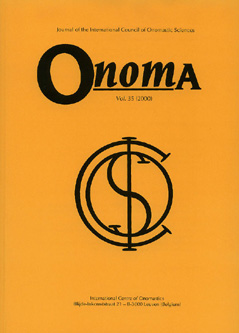 previous article in this issue previous article in this issue | next article in this issue  |

Preview first page |
Document Details : Title: Shibbolethnonyms, Ex-Exonyms and Eco-Ethnonyms in Aboriginal Australia Subtitle: The Pragmatics of Oxymization and Archaism Author(s): McCONVELL, Patrick Journal: Onoma Volume: 41 Date: 2006 Pages: 185-214 DOI: 10.2143/ONO.41.0.2119616 Abstract : There are some 300 language names in Australia which generally also name groups of people, and many more names for dialect or clan groups, running into the thousands. Quite a number of these names are opaque: they have no meaning other than that they are ethnonyms today, and none seems discoverable. Others have quite transparent meanings while still others can yield a meaning when subject to etymological analysis, which I call semi-transparent. Within the transparent and semi-transparent categories, three main types will be defined and analysed in this paper: shibbolethnonyms, directional exonyms and environmental ethnonyms. The purpose of the paper is to establish the existence of these three types of ethnonym, in order to introduce the new concept of an ethnonymic paradigm, exploring how such paradigms come into existence, develop and wither, with detailed exemplification from the situation in Australia. Il ya quelque 300 noms de langues en Australie qui sont généralement aussi le nom de groupes de personnes, et beaucoup plus de noms pour les groupes de dialectes ou de clans, des milliers. Bon nombre de ces noms sont opaques: ils n’ont pas d’autre signification que celle, unique, d’ethnonymes aujourd’hui, et aucun ne semble explicable. D’autres ont une signification tout à fait transparente; d’autres encore peuvent produire du sens lorsqu’ils sont soumis à l’analyse étymologique: je les appelle semi-transparents. Dans les catégories transparents et semi-transparents, trois principaux types seront définis et analysés dans le présent article: shibbolethnonymes, anciens exonymes et ethnonymes environnementaux. Le but de cet article est d’établir l’existence de ces trois types d’ethnonyme, afin d’introduire le nouveau concept d’un paradigme ethnonymique, explorer comment ces paradigmes naissent, se développent et disparaissent, avec des exemples détaillés tirés d’Australie. Es gibt ungefähr 300 Sprachnamen in Australien, die gleichzeitig Gruppen bezeichnen; die Namen für Dialekt- und Clangruppen gehen in die Tausenden. Eine ganze Reihe dieser Namen ist ungeklärt: sie haben keine Bedeutung außer dass sie heute Enthonyme sind, weitere Bedeutungen scheinen sich nicht feststellen zu lassen. Andere Namen besitzen recht transparente Bedeutungen, und bei wieder anderen können Bedeutungen festgestellt werden, wenn sie einer etymologischen Analyse unterzogen werden—diese nenne ich semitransparent. Innerhalb der transparenten und semi-transparenten Kategorien werden in diesem Paper drei Haupt-Typen definiert und analysiert werden: Shibbolethnonyme, direkt ausgerichtete Exonyme und Ethnonyme der Umwelt. Ziel des Papers ist es, die Existenz dieser drei Typen von Ethnonymen zu begründen, um das Konzept eines ethnonymischen Paradigmas vorzustellen und zu untersuchen, wie solche Paradigmen entstehen, sich entwickeln und wieder verschwinden. Dieses soll anhand detaillierter Beispiele der Situation in Australien geschehen. |
|


